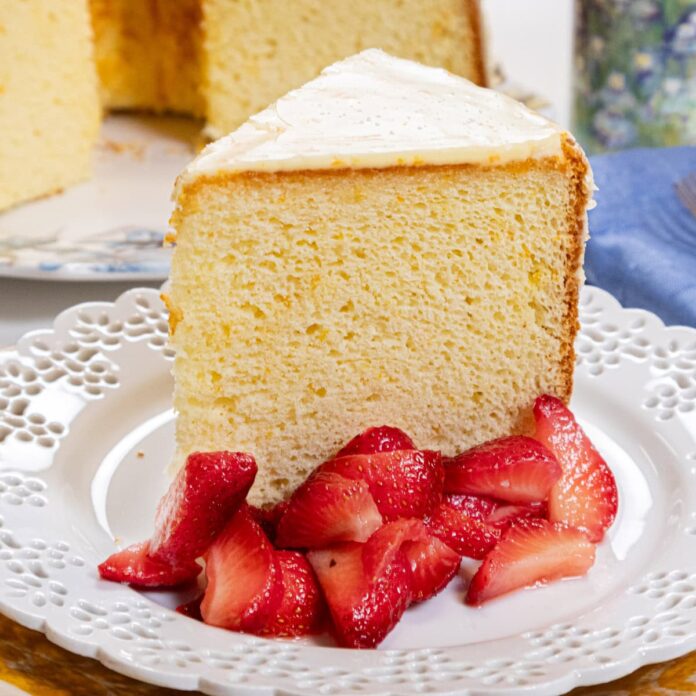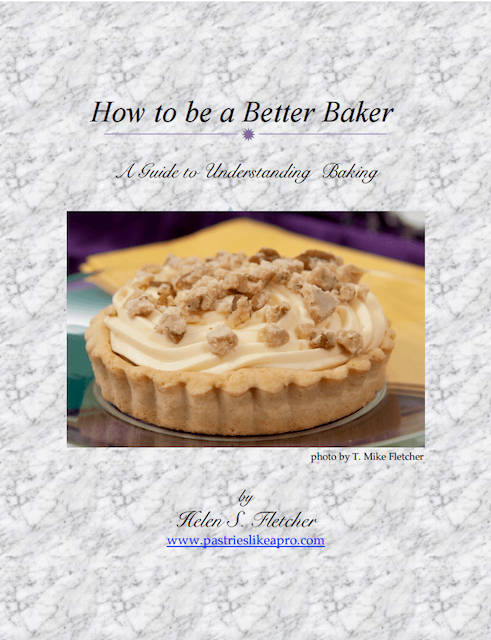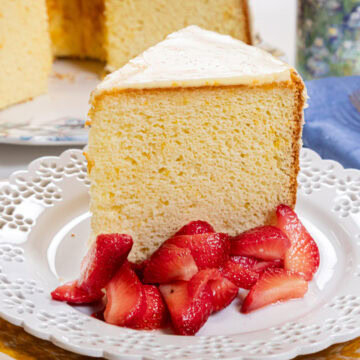Orange Chiffon Cake is one of the easiest cakes to make. It is light and airy, deeply flavored and basically takes two steps to make. I’m going to show you an easier way to whisk the egg whites and sugar that is hassle free and doesn’t require the slow addition of sugar to the egg whites.
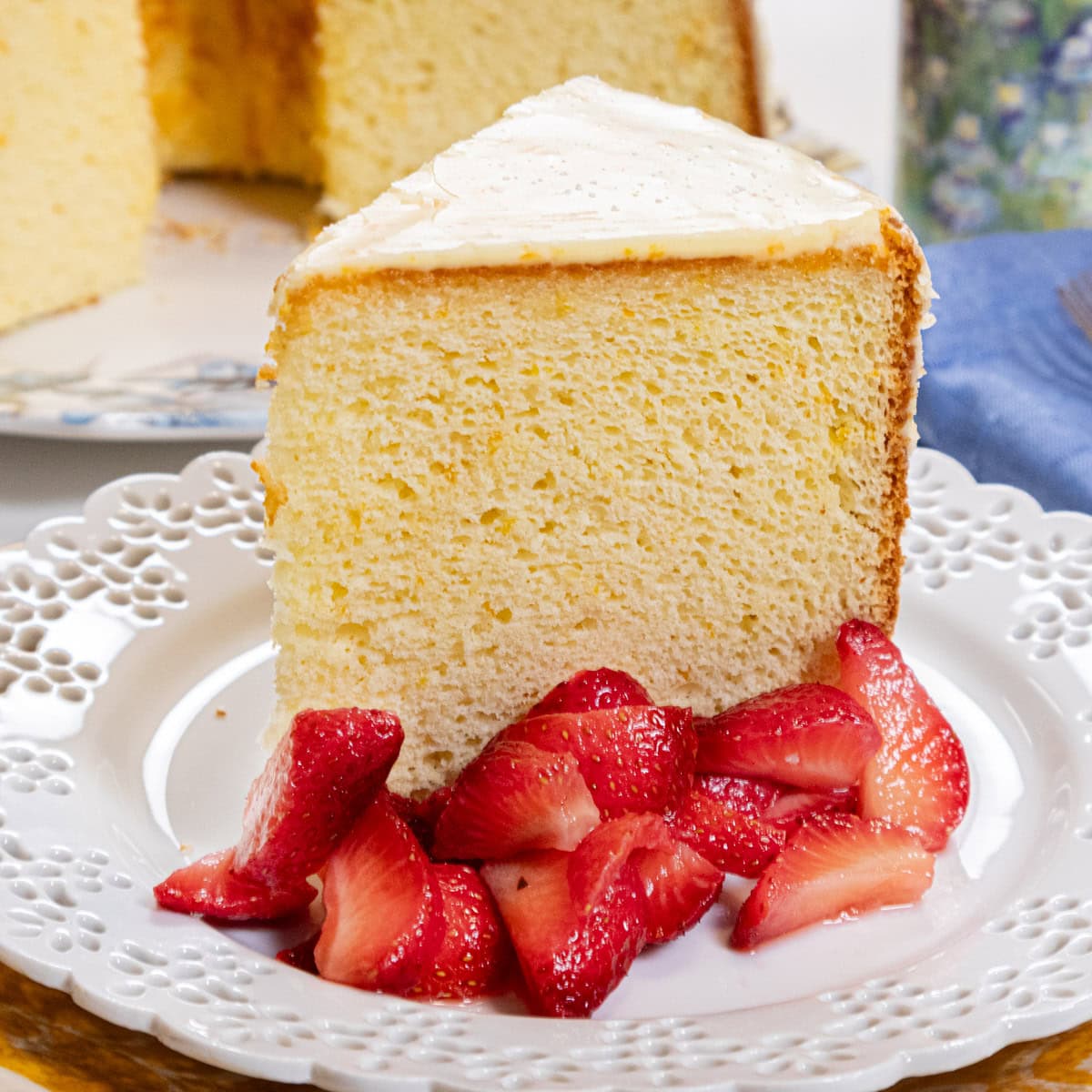
The cake can be made in an angel food pan or in layers as I did for the Orange Cranberry Cake. It can be served plain with just a dusting of powdered sugar, add some macerated fresh fruit or finished with an orange glaze. It’s ideal for an impressive looking cake with a lot fewer calories than most.
This is one cake that should definitely be in your repertoire.
Jump to:
What is a Chiffon Cake
There are several classifications of cakes and one of them is the foam cake such as my Perfectly Easy Angel Food Cake, or my Lemon Butter Sponge Cake. These cakes depend, in part or in whole, on whipped egg whites to provide the volume of the finished item after baking. The egg whites make a foam that are folded together with the flour portion of the recipe. Some recipes may also use baking powder as an aid, but the essential thing is the beaten egg whites.
Chiffon cakes are very easy to make. They have oil in them which automatically contributes to a moist cake. The lack of flavor from the vegetable or canola oil allows whatever the cake is flavored with to come to the front and be the predominant flavor. They also have baking powder as an assist to rising which makes them easier than recipes that depend completely on the air in the whipped egg whites.
You simply mix everything but the egg whites and sugar together and then separately, the whip the egg whites and sugar then fold them together.
Beating Sugar and Egg Whites
Here’s the part you’re going to love. Traditionally, egg whites are beaten to the soft peak stage and then the sugar is added a tablespoon at a time. However, there is a more modern way to combine them. Simply combine the egg whites along with the sugar and cream of tarter if using in a clean mixing bowl fitted with a clean whisk attachment. Beat until the desired consistency.
Use baker’s sugar if possible as it will dissolve better and faster than regular granulated sugar – see my post Three Easy Sugar Fixes which tells you how to make brown sugar, powdered or confectioners sugar, and superfine or baker’s sugar at home. Baker’s sugar is a finer grind of granulated sugar but not powdered sugar which contains cornstarch.
If folding beaten egg whites into a recipe they should be beaten to a medium consistency. If they are beaten too stiffly they will lose a lot of the air beaten in because it will take longer with more effort to fold in completely without what I refer to as “clouds” or unfolded whites in your finished recipe .
Why You’ll Love this Recipe
- It’s really easy. If you can separate an egg you have it made.
- There are basically two steps. Beat the yolk with everything but the whites and sugar then fold together.
- The whites and sugar can be beaten together from the start, eliminating the need to spoon the sugar in gradually.
- The cake stand tall and elegant if made in an angel food pan but can also be used for layer of a cake.
- The cake needs only a sprinkling of powdered sugar or a simple orange glaze to finish it.
Variations
- The orange zest and juice can be changed to lemon zest and juice.
- A great combination is to use a chocolate glaze such as my Dark Satin Ganache as used in the Boston Cream Pie. In this case I would use half of it.
- Serve it with sweetened fruit or macerate the fruit in Amaretto.
Recipe Ingredients
Orange Chiffon Cake
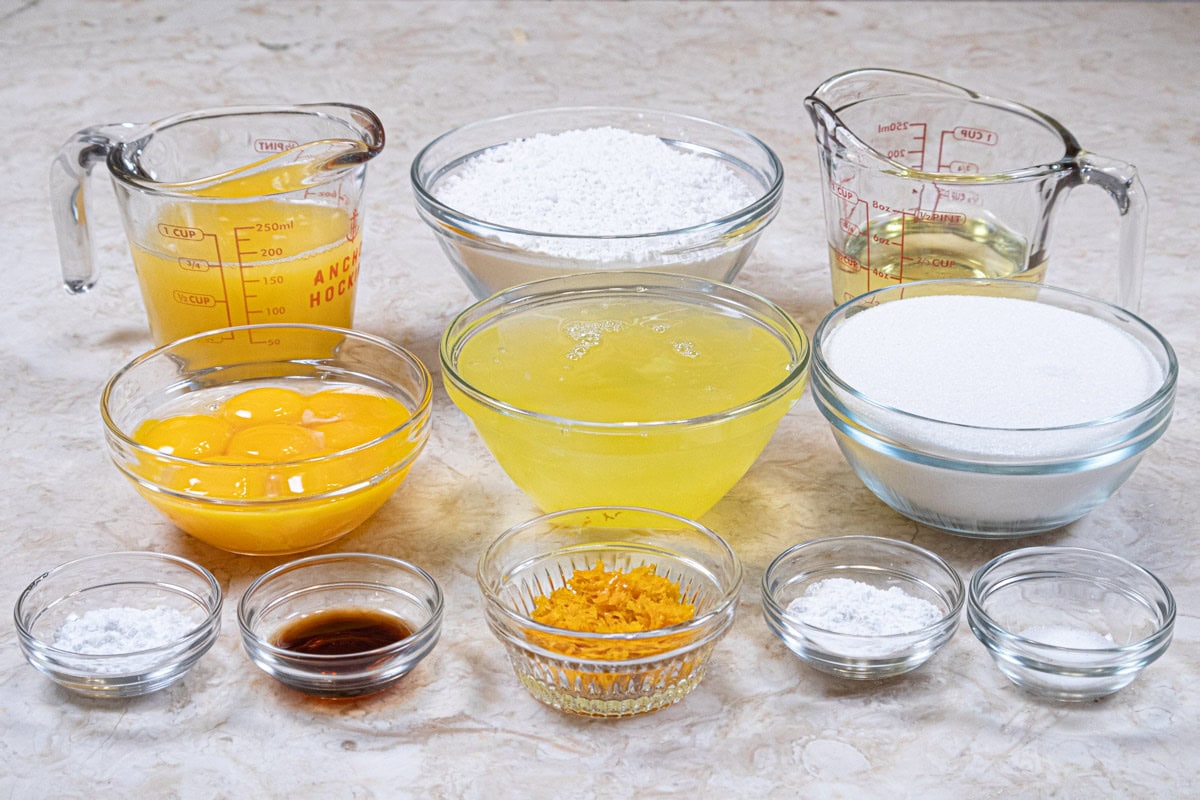

FRONT ROW: Cream of Tarter, vanilla extract, orange zest, baking powder, salt.
MIDDLE ROW: Egg yolks, egg whites, granulated sugar
BACK ROW: Orange Juice, cake flour, vegetable oil
Orange Glaze Ingredients
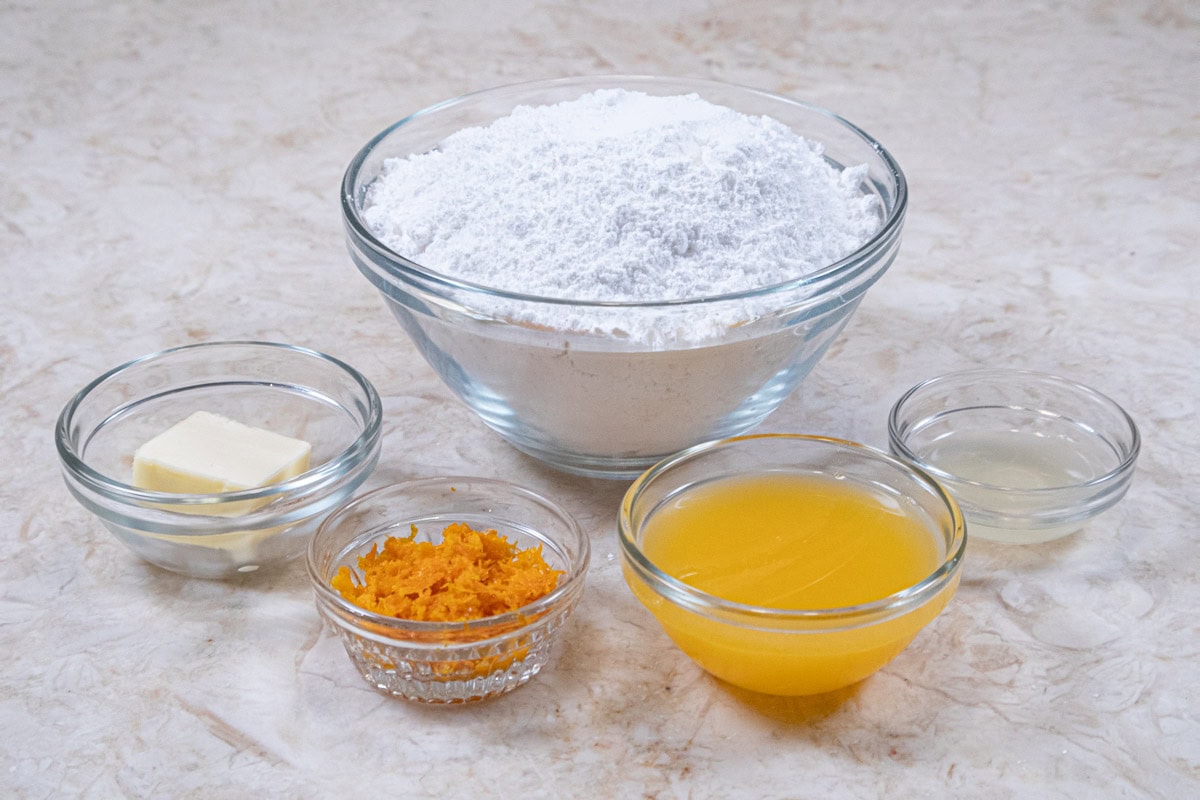

FRONT ROW: Unsalted butter, orange zest, orange juice, lemon juice
BACK ROW: Powdered sugar.
Be sure to see the recipe card below for the full ingredients & instructions.
Step by Step Instructions
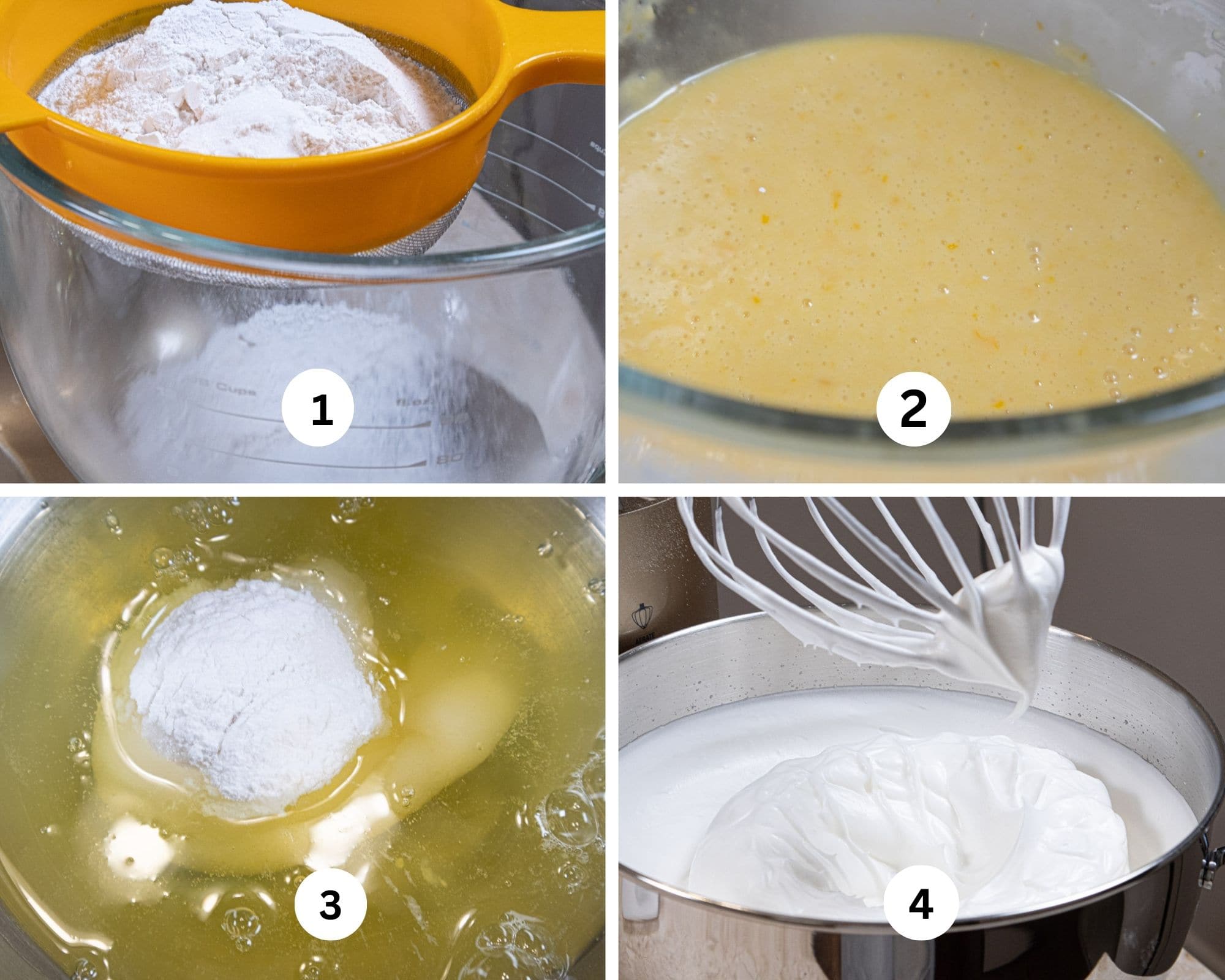

Step 1. Sift the cake flour, 1 cup of sugar, baking powder and salt into a mixing bowl fitted with the paddle attachment. Mix briefly to combine. Step 2. Add the oil, egg yolks, juice, orange zest and vanilla. Mix for about 2 minutes to combine completely. Step 3. In a clean mixing bowl fitted with the whisk attachment, add the egg whites, remaining sugar and cream of tarter. Step 4. Beat on low to combine, raise the speed to medium and beat until foamy, then raise to high and beat until medium peaks form.
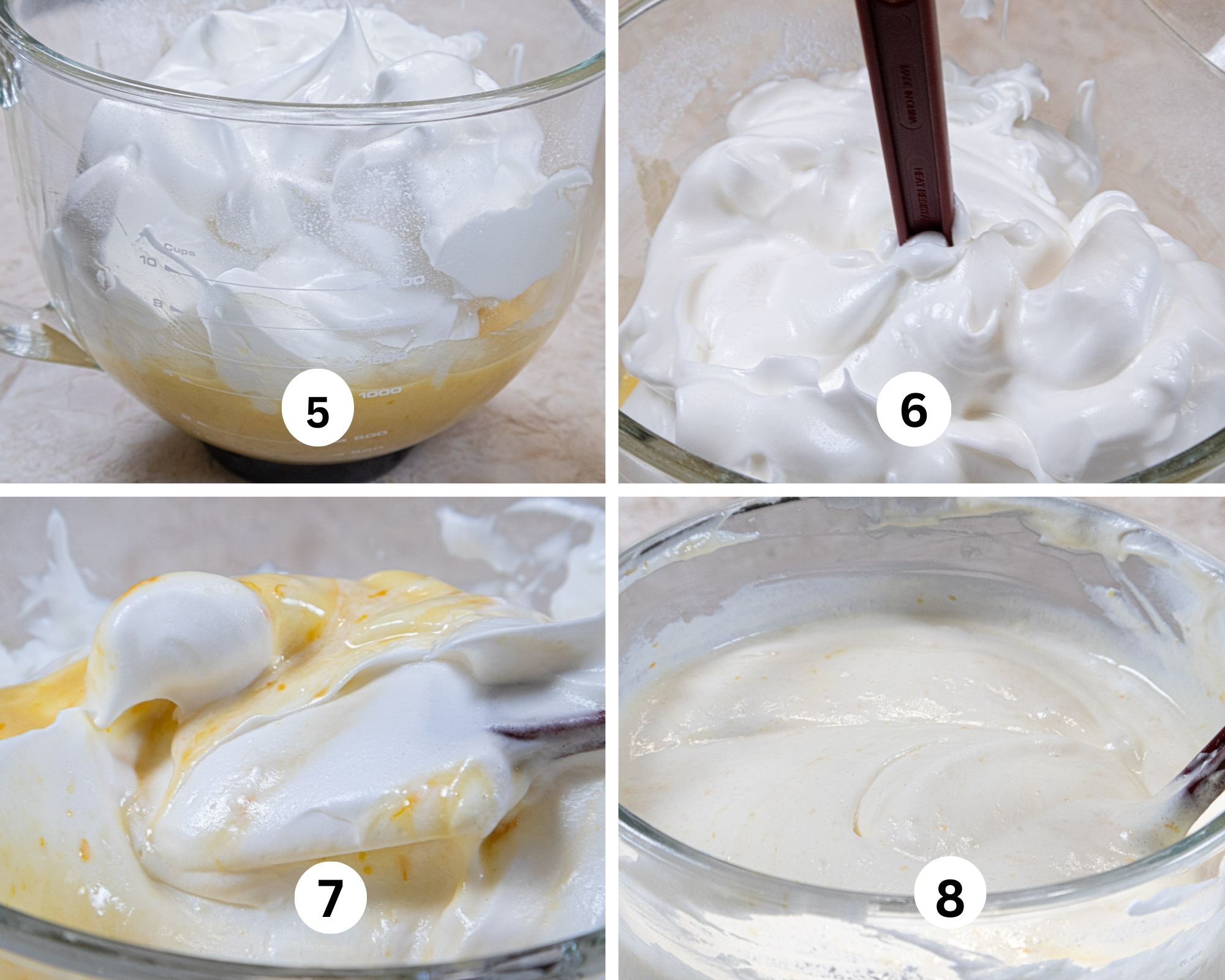

Step 5. Pour the egg whites over the flour/egg mixture. Step 6. To fold in, plunge a plastic spatula into the center of the whites going all the way to the bottom of the bowl. Step 7. Scoop up some of the bottom mixture, bringing it to the top and turn it over onto the whites. Step 8. Turn the bowl about an eighth of a turn each time and repeat this, making sure you get to the bottom of the bowl each time until the two are mixed together.
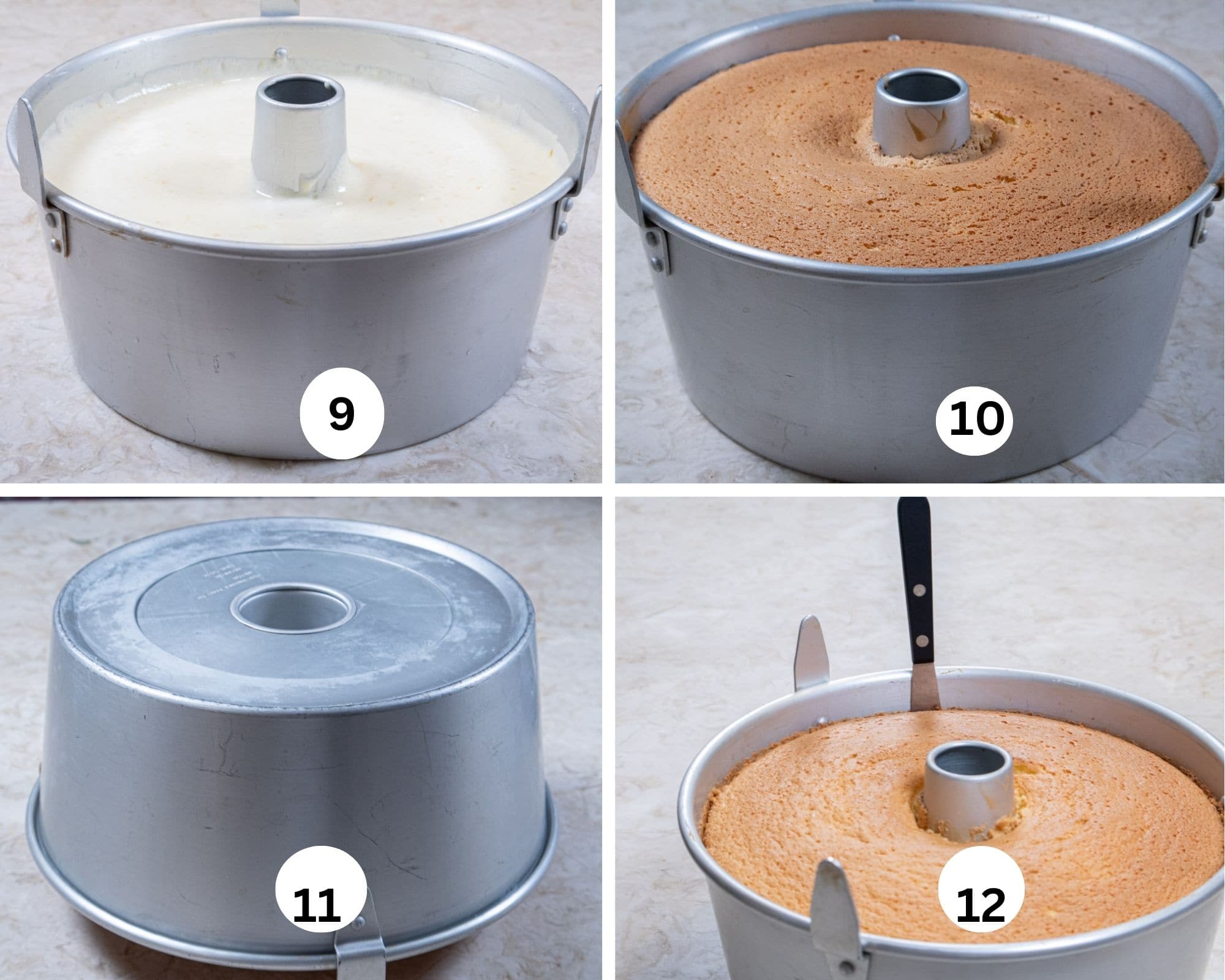

Step 9. Pour the batter into an ungreased angel food pan and smooth the top. Step 10. Bake as directed. Step 11. Cool the orange chiffon cake upside down. If the pan doesn’t have feet on it, hang the pan on a soda or beer bottle to cool. Step 12. To release the cake, place a small flexible metal spatula between the cake and the edge of the pan. Go around the rim of the pan, keeping the spatula on the metal rim, not the cake. Release the cake around the tube in the same manner.
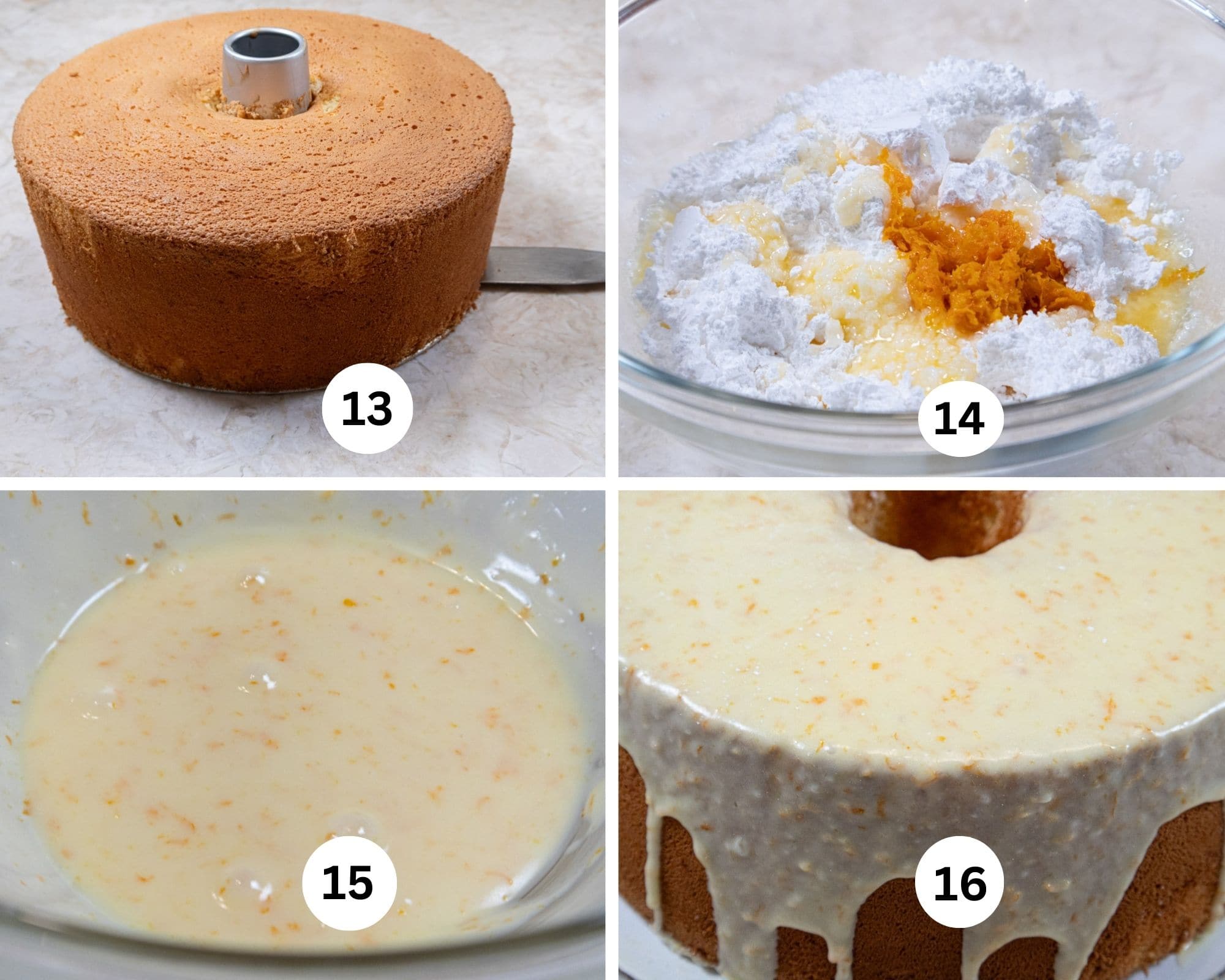

Step 13. To release the cake from the bottom, place a metal spatula between the metal bottom and the cake. Go around the bottom and turn the cake onto a cake board or serving dish. Step 14. Combine all of the glaze ingredients in a bowl. Step 15. Mix the ingredients together with a spoon. Do not use a whisk as it can make air bubbles in the glaze. Step 16. Pour the glaze over the cake letting the glaze run down the sides.
Recipe FAQS
An angel food cake pan is very tall. If it were to be greased or prepared in any way the cake could slide down the side during baking as the sides set faster than the middle. The cake could lose some of it height losing its airy, light quality which is the point of these cakes.
The angel food cake is made of only egg whites, sugar, flour, salt, flavoring and cream of tartar. Air whisked into the whites is the only leavening agent. Chiffon cakes have all of the above plus egg yolks, baking powder, and oil. They both used beaten egg whites.
Because it is light and airy like
Harry Baker, a caterer in 1927, invented the cake and kept the recipe to himself until he sold it to Betty Crocker in 1948.
Storage and Freezer Instructions
The cake can be stored at room temperature, covered for several days. It can also be baked and frozen, without the glaze, and well wrapped, for several months. Thaw, unwrapped at room temperature. Glaze after it come to room temperature.
Expert Tips
- Navel Oranges are the best for zesting as their skins are thicker and their juice is often sweeter. Three medium size oranges will yield the zest and juice needed for both the cake and the glaze.
- This cake, simply finished with powdered sugar is lower in fat that those with frosting and filing.
- Using superfine or baker’s sugar with the egg whites allows the sugar to dissolve faster than with regular granulated sugar.
- Do not beat the whites and sugar to stiff peaks. They don’t fold well into the flour mixture.
- Folding the two mixtures together should be done with as few strokes as possible to keep the air in the mixture.
- Cool the cake completely before releasing.
- The three extra egg yolks can be thrown into scrambled eggs or used for Lemon Curd.
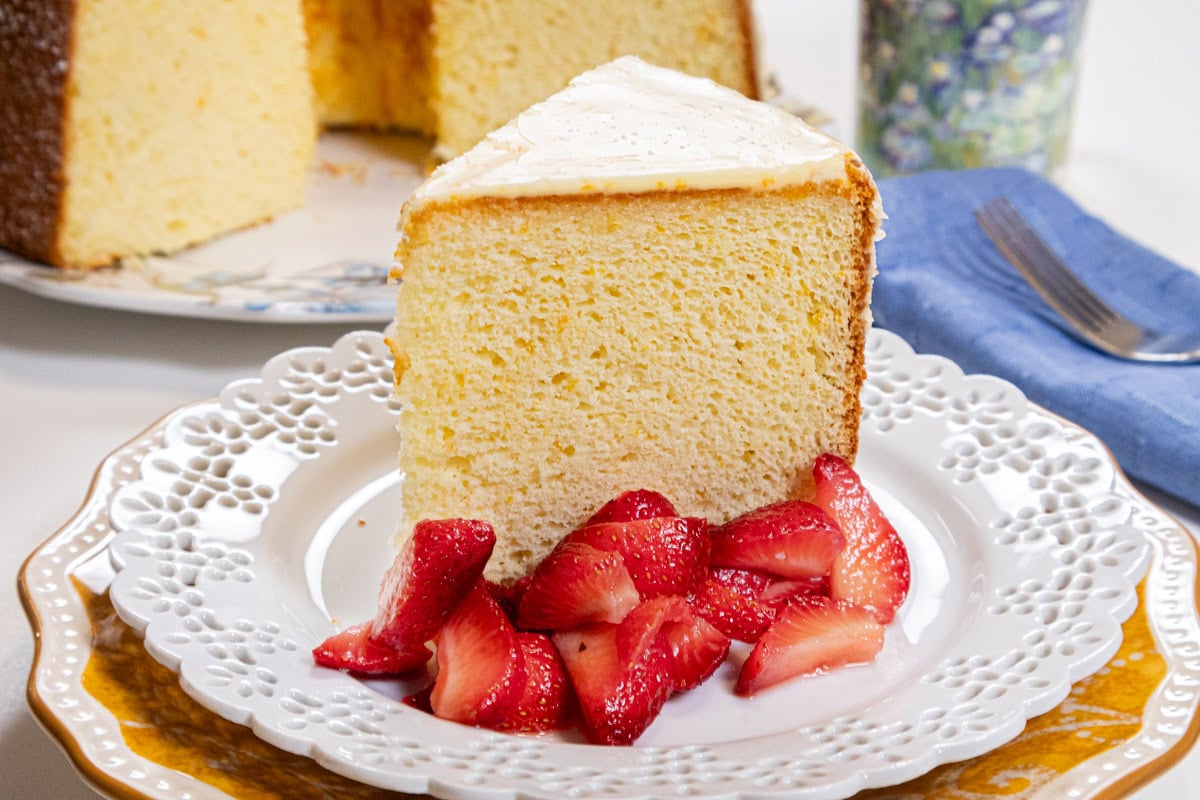

Other Easy Cakes You’re Sure to Love
If you love this Orange Chiffon Cake It would be hugely helpful and so appreciated it if you would take a moment to leave a rating. Thank you.
Orange Chiffon Cake
Orange Chiffon Cake is one of the easiest cakes to make. It is light and airy, deeply flavored and basically takes two steps to make. I’m going to show you an easier way to whisk the egg whites and sugar that is hassle free and doesn’t require the slow addition of sugar to the egg whites.
Equipment
-
Angel Food Cake pan
-
Stand Mixer
Instructions
Orange Chiffon Cake
-
Preheat the oven to 325°F. Have the 10″ angel food cake at hand.
-
In a large mixing bowl fitted with a paddle attachment, combine the flour, 1 cup of sugar (200 grams), baking powder and salt. Mix to combine. .
-
Add the oil, egg yolks, juice, vanilla and zest. Mix for about 1 or 2 minutes until well combined. Set aside.
-
In a clean mixing bowl fitted with the whisk attachment, add the egg whites, remaining ½ cup of sugar (100 grams) and the cream of tartar. Beat on low to mix, raise the speed to medium and beat until very foamy, then raise to high and beat until medium peaks. The peaks should not bend over as in soft peaks, nor should the be as stiff as for a meringue,
-
Pour the whites over the flour mixture and fold together. To fold in, plunge a plastic spatula into the center of the egg whites all the way to the bottom. Scoop up some of the flour mixture and bring it up to the top, turning the spatula over to deposit it. Turn the bowl about an eighth of a turn and continue in this manner until the two are mixed.
-
Pour the batter into the unprepared angel food pan and level it. Bake for 45 to 50 minutes until medium brown, it springs back when lightly touched or a tester comes out clean.
-
Immediately, turn it upside down to cool if the pan has feet or hang it on a soda or beer bottle to cool.
-
When completely cool, go around the sides of the pan with a small, flexible metal spatula, keeping the spatula to the edge of the pan, not the cake. Release the center tube in the same manner. Remove the side.
-
To remove the bottom, place a spatula between the metal bottom and the cake. Go around the whole bottom keep the spatula to the metal base.
-
Place a cake round or serving plate over the top and turn the chiffon cake out. it’s normally served upside down.
Orange Glaze
-
Combine all of the ingredients in a bowl and mix with a spoon. Do not use a whisk as it can make air bubbles. If it is too thick, add a bit more juice or water, if too thin, add a little powdered sugar to get to the right consistency.
-
Pour over the cake allowing the excess to run down the side of the cake.
-
To store, place under a cake dome where it will last for several days. For longer storage, freeze the cake, without the glaze, until hard. Wrap well. It will keep for several months. Thaw, uncovered at room temperature. Glaze after it is thawed.
Notes
As always, I recommend using a scale for accuracy and consistency. Flour, in particular, is difficult to measure by volume. For my recipes, I use 140 grams per cup of unsifted all-purpose, bread or whole wheat flour and 125 grams of cake flour. Others may use different weights so use whatever they suggest.
______________________________________________________
Navel Oranges are the best for zesting as their skins are thicker and their juice is often sweeter. Three medium size oranges will yield the zest and juice needed for both the cake and the glaze. If you’re slightly short of juice, add water.
This cake, simply finished with powdered sugar is lower in fat that those with frosting and filing.
Using superfine or baker’s sugar with the egg whites allows the sugar to dissolve faster than with regular granulated sugar.
Do not beat the whites and sugar to stiff peaks. They don’t fold well into the flour mixture.
Folding the two mixtures together should be done with as few strokes as possible to keep the air in the mixture.
The three extra egg yolks can be thrown into scrambled eggs or used for Lemon Curd.
Cool the cake completely before releasing.
Nutrition
Serving: 12servingsCalories: 325kcalCarbohydrates: 65gProtein: 8gFat: 4gSaturated Fat: 2gPolyunsaturated Fat: 1gMonounsaturated Fat: 1gTrans Fat: 0.05gCholesterol: 111mgSodium: 232mgPotassium: 174mgFiber: 1gSugar: 47gVitamin A: 232IUVitamin C: 11mgCalcium: 64mgIron: 1mg

